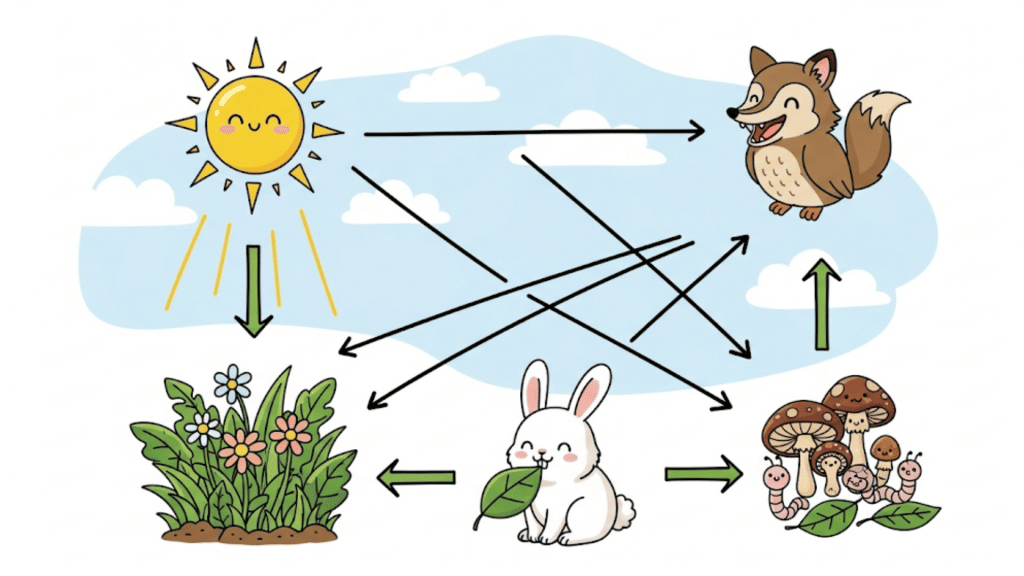If you’ve ever tried to explain how nature works to kids, you know it can feel tricky. That’s where a simple food web worksheet comes in.
In this guide, I’ll walk you through what food webs are, how they’re different from food chains, and the key terms you and your students need to know.
You’ll also find free printable worksheets, fun classroom and home activities, and extra resources like games, flashcards, and books.
By the end, you’ll have everything you need to make learning about ecosystems clear, engaging, and practical.
Understanding Food Webs
Food webs illustrate the connections between living things in nature. They demonstrate how energy is transferred from one organism to another.
Every plant, animal, and tiny organism plays a role. Without these connections, ecosystems would not stay balanced.
A food chain is the simplest way to show energy flow. It’s a straight line that goes from one organism to the next, like sun – grass – rabbit – fox.
A food web is more detailed. It combines many food chains together. This is closer to how nature really works, since most animals consume more than one type of food. A bird might eat insects, seeds, and berries.
That’s why food webs give us a clearer picture.
Why Visuals Help
A food web diagram is one of the best tools for learning. Arrows point from one organism to another, showing the flow of energy.
- It engages visual learners who learn best by seeing.
- It clearly illustrates the interconnectedness of producers, consumers, and decomposers.
- It supports teachers in classrooms and helps with homework or homeschooling.
- It encourages children to think more deeply about balance in nature.
When students look at a food web, they see how everything depends on everything else. If one species is removed, it can significantly impact the entire web.
That’s why visuals don’t just teach science; they help students understand the importance of protecting ecosystems.
Key Terms in Food Web You Should Know
Knowing these terms makes it easier to follow how energy and nutrients move through an ecosystem.
- Producers: Plants that make their own food using sunlight. They are the first step in every chain or web.
- Consumers: Animals that eat plants or other animals. They can be herbivores, carnivores, or omnivores.
- Decomposers: Fungi, bacteria, and some insects that break down dead plants and animals. They recycle nutrients back into the soil.
- Trophic levels: The levels or “steps” in a chain or web. Plants are at the bottom, and top predators are at the top.
Free Printable Food Web Worksheets
I’ve put together a set of kid-friendly food web worksheets you can download and use right away.
The PDF includes a food chain basics worksheet for younger learners, an ecosystem food web worksheet that shows how nature connects, and a cut-and-paste activity that makes learning hands-on.
Kids can also try a label-the-food-web worksheet to practice naming producers, herbivores, carnivores, and omnivores, or use a blank template to create their own food webs
These pages are colorful, easy to use, and designed to keep kids engaged while learning how energy moves through ecosystems.
Classroom & Home Activities with Food Web Worksheets
Food web worksheets can be used in many fun and simple ways. They help kids learn while keeping them engaged. Teachers and parents can pick activities that match the child’s age and skill level.
- Group Activities: Students build a food web together. Each represents an animal or plant, and strings or arrows show the connections.
- Worksheet Quizzes: Use worksheets with short quizzes. Ask students to label producers, consumers, and decomposers or draw arrows for energy flow.
- Coloring Worksheets: Younger kids can color plants, animals, and arrows while learning food chain basics.
- Poster Projects: Older students can create posters of food webs from ecosystems like forests, oceans, and deserts. Displaying them helps the whole class learn.
Using worksheets in these ways adds variety to lessons. It also makes learning about ecosystems more interactive and memorable.
Additional Resources for Teaching Food Webs
Food web worksheets work best when paired with other tools. Mixing in games, books, and visuals makes learning more engaging for kids.
- Science Games and Online Activities: Students can practice building food webs online. Many free sites let kids drag and drop plants and animals into the right spots.
- Printable Flashcards: Flashcards with pictures of producers, consumers, and decomposers are useful in class or at home. Kids can sort them, quiz each other, or play matching games.
- Books and Videos: Books with clear pictures explain ecosystems in simple ways. Short videos show real examples of how plants and animals depend on each other.
Adding these resources gives kids more ways to learn. It also keeps lessons fresh and supports different learning styles.
Conclusion
I hope this guide helped you see how a food web worksheet can make learning about ecosystems simple and fun.
When we use these worksheets, we give kids a clear way to understand producers, consumers, and decomposers, and how they all stay connected.
You can use them at home, in the classroom, or even for group projects. The best part is you don’t need anything fancy; just print, share, and start learning the links in nature.
If you’re ready, download a free food web worksheet today and make science come alive. I’d also love to hear from you; drop a comment below and share how you plan to use these worksheets!
Frequently Asked Questions
Do food web worksheets come with answer keys?
Yes, many worksheets include answer keys to help teachers and parents quickly check work.
Can food web worksheets be used for homeschooling?
Absolutely. They’re easy to print and pair well with hands-on activities at home.
What skills do kids build with food web worksheets?
Kids practice critical thinking, observation, and understanding of how ecosystems stay balanced.
How can I make worksheets more engaging for kids?
Combine them with drawing, coloring, or group projects so kids learn while staying creative.











